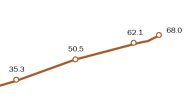
Key facts about U.S. Latinos
Between 2000 and 2024, the U.S. Latino population nearly doubled, rising from 35.3 million to 68 million.
Numbers, Facts and Trends Shaping Your World
All
Publications
Between 2000 and 2024, the U.S. Latino population nearly doubled, rising from 35.3 million to 68 million.
Roughly seven-in-ten Hispanic adults (69%) say that having a Hispanic high school STEM teacher would make young Hispanic people more likely to pursue these degrees.
Three-quarters of Hispanics who have heard of the term Latinx say it should not be used to describe the Hispanic or Latino population.
Government data shows gains in education, employment and earnings for Hispanic women, but gaps with other groups remain.
U.S.-born Latinos mostly get their news in English and prefer it in English, while immigrant Latinos have much more varied habits.
In 2021, nearly 2.5 million Latinos in the United States held advanced degrees such as master’s degrees or doctorates.
In 2021, there were 2.6 million foreign-born Hispanics who had been in the U.S. for five years or less. This is down from 3.8 million in 2000.
Most U.S. Latinos speak Spanish: 75% say they are able to carry on a conversation in Spanish pretty well or very well. But not all Latinos are Spanish speakers, and about half (54%) of non-Spanish-speaking Latinos have been shamed by other Latinos for not speaking Spanish.
In 2022, there were 63.7 million Hispanics living in the United States. The U.S. Hispanic population has diverse origins in Latin America and Spain.
An error in how the Census Bureau processed data from a national survey provided a rare window into how Brazilians living in the U.S. view their identity.
Notifications